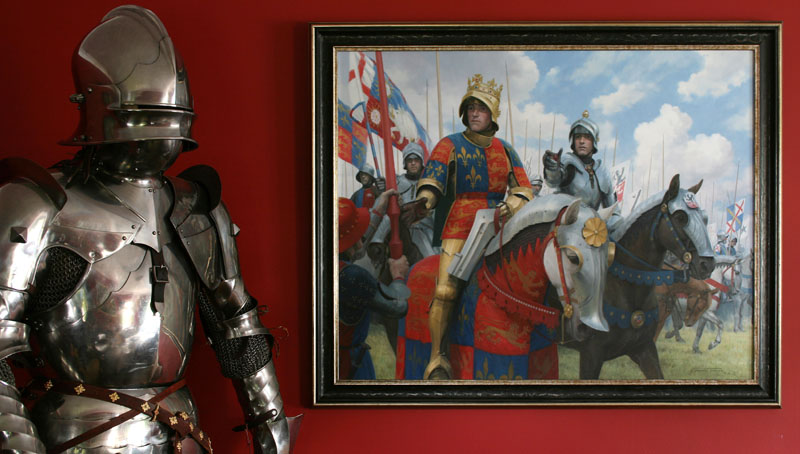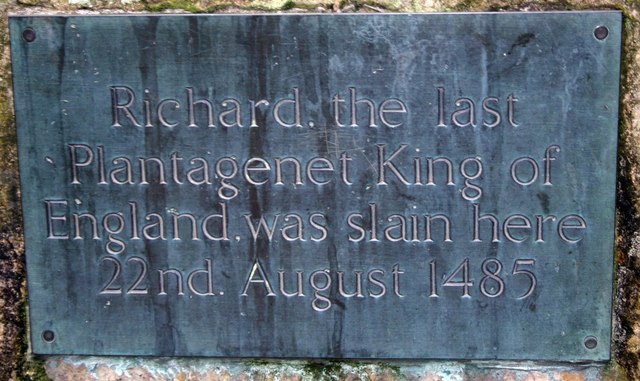
Richard the 3rd was killed in the Battle of Bosworth Field in Leicestershire, central England, on Aug. 22, 1485.
Forensic Evidence confirms that Richard III died a violent death at Bosworth:
King Richard III likely perished at the hands of assailants who hacked away pieces of his scalp and rammed spikes or swords into his brain as the helmet-less monarch fell to his knees in in the mud after his horse sank into mud or was was killed under him.A forensic report published in The Lancet exposes the horrific demise of one of English history’s most controversial monarchs.It backs anecdotal evidence, made famous by Shakespeare, that Richard was unhorsed before he met his doom.
Bringing together 21st-century science and sketchy knowledge of 15th-century history, the analysis provides a chilling tableau of the brutality of warfare in late mediaeval England.
The monarch’s death was the culmination of a three-decade war for the throne, bringing the curtain down on the three-century dynasty of his Plantagenet clan, and ushering in the Tudors.
“The most likely injuries to have caused the king’s death are the two to the inferior aspect [lower part] of the skull – a large sharp-force trauma possibly from a sword or staff weapon, such as a halberd or bill, and a penetrating injury from the tip of an edged weapon,” said Guy Rutty, a pathologist at the University of Leicester.

A halberd was a mediaeval battle axe with spiked point, and a bill was a hooked-tip blade on the end
of a pole.


“Richard’s head injuries are consistent with some near-contemporary accounts of the battle, which suggest that Richard abandoned his horse after it became stuck in a mire and was killed while fighting his enemies,” said Rutty.
The study, published in The Lancet medical journal, used X-ray computed tomography (CT) for a microscopic analysis of a skeleton found in 2012 under a car park at a former church.
After being lost for five centuries, researchers identified the remains as Richard’s, backed by DNA analysis and radiocarbon-dating.
The paper documents nine injuries to the head at or shortly before death, and two to the torso that were likely inflicted postmortem.
The two blows that probably killed the king likely came from a sword or spike driven into the brain at the base of the skull.
They are consistent with the victim having been “in a prone position or on its knees with the head pointing downwards,” the study’s authors wrote.
Non-fatal injuries included three cuts to the top of the skull that would have sliced off much of the scalp. A knife or dagger was stuck right through his face, from right cheek to left.
“Richard’s injuries represent a sustained attack or an attack by several assailants,” said Sarah Hainsworth, a professor of materials engineering at the university.
“The wounds to the skull indicate that he was not wearing a helmet, and the absence of defensive wounds on his arms and hands indicate that he was otherwise still armoured at the time of his death.”
Assuming that he had been wearing his royal armour, two injuries to the trunk must have been inflicted after Richard’s body was stripped, the team said.
One was a blow to the right tenth rib with what was probably a fine-edged dagger.

The other was a thrust, probably by a sword driven upwards through the right buttock that would have penetrated his bowels and other soft pelvic organs – a blow that would have caused fatal bleeding had he been alive.
Without any soft tissue to analyze, the scientists looked at sometimes tiny marks left on the bones – cuts, abrasions, punctures and so on – and compared them with the known impacts caused by the weapons of the time.
The gory reconstruction of his death is heavily dependent on assumptions about the wearing of armour and the loss of his helmet, but chimes with several contemporary accounts.
One version of events penned the year after Richard’s death, said his naked body was slung over his horse like a saddlebag and brought to Leicester.
“Insults” were directed at the corpse by the crowds – which could be when an onlooker inflicted the pelvic wound by thrusting a blade through the king’s buttock, according to the new investigation.
Further mutilation of his corpse would have been stopped – to display his dead body as a trophy, the defeated king had to be recognizable.
Richard died at the age of 32 after only two years on the throne. Contemporary accounts described him as generous and a good monarch, but his reputation was blackened by the victorious Tudors.
In Shakespeare’s play Richard III, the king’s spinal curvature was transformed into a hunchback, and his character was murderous and hungry for power.
England's King Richard III, whose body was discovered under a municipal car park, will be reburied near to where he was slain in battle 500 years ago, a court ruled on Friday, dashing the hopes of his distant descendants who had wanted his remains to be taken back to his northern stronghold.

The unearthing two years ago of the remains of the last English king to die in battle was one of the most important archaeological finds of recent years.
Richard was slain at Bosworth Field near Leicester, central England, in 1485, bringing to an end the rule of the Plantagenet dynasty after 300 years.

His death was the culmination of the Wars of the Roses, a bloody 30-year power struggle between Richard's House of York and the rival House of Lancaster.
The whereabouts of his grave had been a mystery until a skeleton with curved spine and head wounds was found by archaeologists from the University of Leicester, with DNA tests confirming it was indeed the king.

The university was given permission by Britain's Ministry of Justice to re-bury the king at Leicester cathedral.
But the Plantagenet Alliance, a group which included some of Richard's distant descendants, asked London's High Court to block the burial plans, arguing the decision on the final resting place should have been a matter of public consultation.
They wanted their ancestor to be reinterred in the northern city of York, his power base during his 26-month reign.
However, their case was thrown out by three of the country's most senior judge.
"Since Richard III's exhumation of Sept. 5, 2012, passions have been roused and much ink has been spilt," their ruling said. "We agree that is it is time for Richard III to be given a dignified reburial and finally laid to rest."
A tough soldier and popular in the north, Richard remains a hugely divisive figure in English history, seen by some as a monster who murdered two princes - his own nephews - in the Tower of London to take the throne, and by others as an enlightened ruler unfairly maligned by his enemies.
He was cast by Shakespeare as a power-crazed hunchback, who famously went down fighting to keep his crown from the invading forces of Henry Tudor crying out "A horse! A horse! My kingdom for a horse!".
After the battle, the victor, the future King Henry VII, had Richard's naked body exposed to the people of Leicester to show the battle was won before he was buried in a monastery which was later destroyed.
In their ruling, the three judges said Queen Elizabeth was content for the dead king to be buried in Leicester, and did not express a wish for a royal funeral or for a re-interment at London's Westminster Abbey where many medieval monarchs were laid to rest.

The judges also said the Plantagenet Alliance, set up by Stephen Nicolay, the 16th-great-nephew of Richard, represented only a fraction of the number of his descendants.
The alliance said in a statement after the ruling: "We believe that the proposed location of Leicester is wholly inappropriate for the burial of King Richard III, who had no connections with the town beyond his horrific death, bodily despoliation and appalling burial in a foreshortened grave.
"It is fitting and respectful and in keeping with all of our national customs regarding treatment of the dead, to bury this king in a place 'appropriate to him' - that place is York."
The University of Leicester will now go-ahead with plans for the reburial, likely to be early next year, while the city council has unveiled plans for a 4 million pound ($6.6 million) visitor centre around the find, hoping that fascination with the monarch will prove to be a hit with tourists.
"This will be a momentous event for the city and county, and an opportunity to show the rest of the world that Leicester is the rightful resting place for the last Plantagenet King of England," said Leicester Mayor Peter Soulsby.
Richard Buckley, the lead archaeologist on the dig which found the remains, said it was right they stayed in the city.
"Ultimately a King of England by right of conquest - Henry VII - decided in August 1485 to hand over the vanquished King Richard's remains to the Franciscan Friars in Leicester for burial," he said.
"There they have lain for over half a millennium and have become part of Leicester's history."
A facial reconstruction gives us an idea of what he would have looked like in life:

Contemporary paintings seem to confirm the identity of the body, as does DNA evidence.
